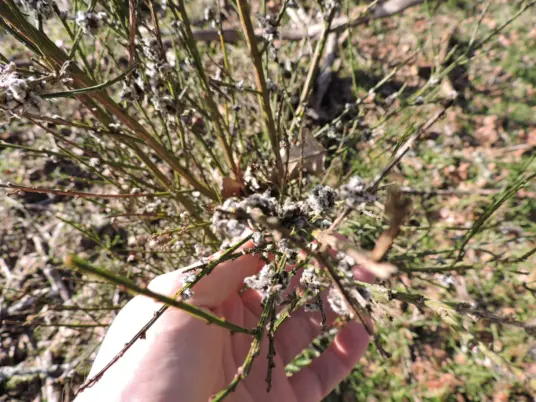Gallingly Happy: A Mite-y Weedkiller at CPTC
by Marcia Wilson
Scotch Broom seems impossible to kill, but in 2021 Dr. Faust found something doing exactly that at the CPTC Outdoor Lab.

Scotch Broom, Cytisus scoparius, is a noxious ornamental bush brought to Washington State years ago. Sadly, it spreads quickly and out the valuable native plant life we need for healthy water, soil, and wildlife support. The plants are full of toxic alkaloids that can poison children, pets, and specific livestock.
Removing this pest is easier said than done. At the CPTC Outdoor Lab the students and volunteers clock hundreds of hours in digging up or cutting down the shrubs. Mature specimens can be over ten feet tall and nearly as wide with strong, woody stems and roots. Destroying the brooms require long, hard hours of labor with heavy tools. Herbicides are only a short-term solution, and burning is dangerous because the oily plants are highly flammable.
But in 2021, Dr. Faust noticed a cluster of sickly-looking Brooms on the western side of the Lab. He identified the cause as Aceria genistae, or the Scotch Broom Gall Mite. This is the main biological control against Scotch Broom.
How it Works
“Gall” means “irritant.” Plant galls are formed like scar tissue from mites chewing and feeding on their host. Sometimes a gall looks awful, it doesn’t always harm the plant. A. genistae forms galls about the blossom stems. Imperfect blossoms do not easily pollinate or develop healthy seeds. Given enough time, broom mites can weaken the broom to the point of death.

How the mites arrived at CPTC is a mystery for another day, but it is possible they spread from an infected patch many miles away. Mites are so small and light they can travel on the wind or hitch a ride on passing birds. In the fall their galling homes shrivel up so they travel to a fresh spot, and burrow down to escape the cold winter about to come. Finding a gall mite is nearly impossible because they are almost too small to be seen by the human eye. It is much easier to prove their presence by their galls. Luckily for the war against Scotch Broom, introducing the mites can be as simple as tying infected branches on to a healthy plant and letting the mites do the work. The mites may work slowly, but they are ultimately effective against our foe.